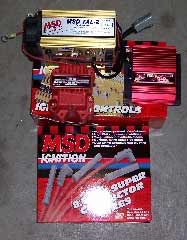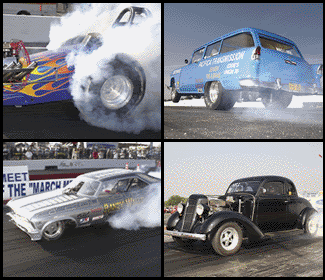| 

Here are all
the MSD goodies on display. The 7AL-2
and HVC2 coil will supply all the juice
I could ever need. The red box on the
right is the Programmable Launch Rev
Limiter and will merit some more attention
in a future article. |
So, now we have fuel. We need to light it!
I have used ignition products from MSD since
my very first car and have always been happy
with the result. For the last 10 years I have
used the same MSD 6 AL 2 box without fail but
I decided that maybe I should start fresh at
this time. My first thought was to go with
one of the new “fancy” digital
setups but after looking at ALL of the features
and possible usage’s of the digital units
I realized that I wont use HALF of their capabilities.
Also, I already have an MSD multi-step retard
unit and it won’t work with the digital
boxes. Don’t get me wrong, the digitals
are pretty cool and I will probably go to a
programmable 7 someday, but not now with the
current car setup.
I called MSD and talked to Todd Ryden. Just
as I did with the fuel system, I told Todd
what I was doing and what I needed for features.
He suggested I go with what used to be the
king stuff before the digitals came along,
the MSD 7AL2. This baby is one hell of a flame-thrower
and has been track proven to provide all the
power I could use. Also, I went with the new
HVC II coil (Part No. 8261) for the 7 series
ignitions. I also needed a new distributor
to send the spark, so I went with an MSD Pro
Billet unit. To finish off the install I got
some MSD Super Conductor wires and made them
up myself.
So far, most of the parts are pretty normal,
well-known components that literally thousands
of enthusiasts have used for years. The one
MSD component that I will bet not too many
drag racers are aware is available is called
the Programmable Launch Controller (Part No.
7561). This unit is made to work with any of
MSD’s non-digital boxes.
I was telling Todd that eventually when the
new combo is sorted out I am kind of worried
about doing too big and too violent of wheelies.
I know, I always end my article with “When
in doubt. . .DO A WHEELIE!” But, I don’t
necessarily want to destroy the car either!
I had figured on trying to pull some timing
out at the launch to cut power, but Todd told
me he knew what I needed and wanted me to try
it. First off, this is NOT technically a traction
ADVERTISEMENT
 |
control device. There are NO sensors or any
other inputs going into the unit. What you
do is program in a time-based rev limit. I’m
planning on doing a more detailed article about
this device in the future, so for now I will
just give you the basics.
Todd explained to me that originally this
unit was intended for the boat racers to help
control the engine rpm’s on launch, hopefully
saving some wear and tear on drivetrain pieces.
The primary usage in the drag racing world
would be to help control wheel speed and tire
spin on a slick track. I know this sounds like
traction control, but it has NO inputs from
sensors or other telemetry feeding any information
back to the unit. It is basically a programmable
2-step. With the use of a laptop (or the available
hand-held controller), racers can program in
a predetermined low-side rpm (such as your
current 2-step rpm), then at the release of
the button or whatever you use as a trigger,
you can have the programmable launch controller
hold the rpm’s at a certain level for
a certain amount of time until it finally lets
the engine run at full power up to the user
programmed high-side rpm. All of the rpm and
time aspects of the program are mapped in graph
form and the program is very user friendly.
You can learn more by visiting MSD’s
webpage and searching for Part No. 7561. It
is simple to install and simple to operate.
Also, MSD has an adjustable low-side unit that
simply plugs in, allowing the racer to make
low-side adjustments with the twist of a knob
instead of having to break out the laptop.
I wrapped up the ignition install with one
of MSD’s shift-lights and ACCEL U-Groove
plugs.

|